Right of Way Rules
General Information
Right-of-way rules together with courtesy and common sense help to promote traffic safety. It is important to respect the right-of-way of others, especially pedestrians, motorcycle riders, and bicycle riders.
Respecting the right-of-way of others is not limited to situations such as yielding to pedestrians in crosswalks, or watching carefully to ensure the right-of-way of bicyclists and motorcyclists. Motorists must respect the rightof- way of others by not violating traffic laws such as failing to stop at a stop sign or traffic light, speeding, making unsafe lane changes or illegal turns. Statistics show that a high percentage of injury accidents in California are caused by right-of- way violations.
Pedestrians
Pedestrian safety is a serious issue. One in six traffic fatalities is a pedestrian. Drive cautiously when pedestrians are near because they may cross your path.
A pedestrian is a person on foot or who uses a conveyance such as roller skates, skateboards, etc., other than a bicycle. A pedestrian can also be a person with a disability on a tricycle or quadricycle or in a wheelchair.
- Respect the right-of-way of pedestrians. Always stop for any pedestrian crossing at corners or other crosswalks and at corners with or without traffic lights, whether or not the crosswalks are marked by painted lines.
- Do not pass a car from behind that has stopped at a crosswalk. A pedestrian you can’t see may be crossing.
- Do not drive on a sidewalk, except to cross it at a driveway or alley. When crossing, yield to any pedestrian.
- Do not stop in a crosswalk. You will place pedestrians in danger.
- Remember—if a pedestrian makes eye contact with you, he or she is ready to cross the street. Yield to the pedestrian.
- Pedestrians have the right of way at corners with or without traffic lights, whether or not the crosswalks are marked by painted white lines.
- Allow older pedestrians more time to cross the street.
Information regarding pedestrians who are blind can be found here.
Crosswalks
A crosswalk is that part of the pavement where the sidewalk lines would extend across the street and it is set aside for pedestrian traffic. Every intersection has a pedestrian crosswalk whether or not there are painted lines on the street. Most crosswalks are at corners but they can also be in the middle of the block. Before turning a corner, watch for people about to cross the street. Pedestrians have the right of way in crosswalks.
Crosswalks are often marked with white lines. Yellow crosswalk lines may be painted at school crossings. Most often, crosswalks in residential areas are not marked.
Some crosswalks have flashing lights to warn you that pedestrians may be crossing. Look for pedestrians and be prepared to stop, whether or not the lights are flashing.
Intersections
An intersection is any place where one line of traffic meets another. Intersections include cross streets, side streets, alleys, freeway entrances, and any other location where vehicles traveling on different highways or roads join each other.
- At intersections without STOP or YIELD signs, slow down and be ready to stop. Yield to vehicles already in the intersection or just entering it. Also, yield to the car which arrives first or to the car on your right if it reaches the intersection at the same time as you do.
- At “T” intersections without STOP or YIELD signs, yield to vehicles on the through road. They have the right-of-way.
- When there are STOP signs at all corners, stop first, then follow the above rules.
- When you turn left, give the right-of-way to all vehicles approaching you that are close enough to be dangerous. Also, look for motorcyclists, bicyclists, and pedestrians. On divided highways, or highways with several lanes, watch for vehicles coming in any lane you must cross. Turn left only when it is safe.
Safety suggestion: While waiting to turn left, keep your wheels pointed straight ahead until it is safe to start your turn. If your wheels are pointed to the left and a vehicle hits you from behind, you could be pushed into oncoming traffic. - Yield to traffic before entering the road again if you have parked off the road or are leaving a parking lot, etc.
Roundabouts
A roundabout is an intersection where traffic travels around a central island in a counterclockwise direction. Vehicles entering or exiting the roundabout must yield to vehicles, bicyclists, and pedestrians.
When you approach a roundabout:
- Slow down as you approach the intersection.
- Yield to pedestrians and bicyclists crossing the roadway.
- Watch for signs and pavement markings that guide you or prohibit certain movements.
- Enter the roundabout when there is a big enough gap in traffic.
- Drive in a counterclockwise direction. Do not stop or pass other vehicles.
- Use your turn signals when you change lanes or exit the roundabout.
- If you miss your exit, continue around until you return to your exit.
Multiple and single lane roundabout
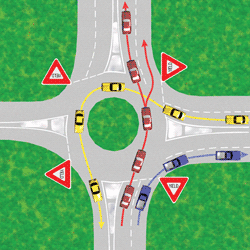
For roundabouts with multiple lanes, choose your entry or exit lane based on your destination. For example, to:
- Turn right at the intersection, choose the right-hand lane and exit in the right-hand lane. (Blue car)
- Go straight through the intersection, choose either lane, and exit in the lane you entered. (Red car)
- Turn left, choose the left lane, and exit. (Yellow car)
On Mountain Roads
When two vehicles meet on a steep road where neither can pass, the vehicle facing downhill must yield the right of way by backing up until the vehicle going uphill can pass. The vehicle facing downhill has the greater amount of control when backing.
Traffic Signal Lights
 Solid Red. A red signal light means “STOP.” You can make a right turn against a red light after you stop and yield to pedestrians, bicyclists, and vehicles that are close enough to be a hazard. Make the right turn only when it is safe. Do not turn if a “NO TURN ON RED” sign is posted.
Solid Red. A red signal light means “STOP.” You can make a right turn against a red light after you stop and yield to pedestrians, bicyclists, and vehicles that are close enough to be a hazard. Make the right turn only when it is safe. Do not turn if a “NO TURN ON RED” sign is posted.
 Red Arrow- A red arrow means "STOP". Remain stopped until the green signal or green arrow appears. Do not turn against a red arrow.
Red Arrow- A red arrow means "STOP". Remain stopped until the green signal or green arrow appears. Do not turn against a red arrow.
 Flashing Red- A flashing red signal light means "STOP." After stopping, you may proceed when it is safe. Observe the right-of-way rules.
Flashing Red- A flashing red signal light means "STOP." After stopping, you may proceed when it is safe. Observe the right-of-way rules.
 Solid Yellow- A yellow signal light means "CAUTION." The red signal is about to appear. When you see the yellow light, stop if you can do so safely. If you can’t stop safely, enter the intersection cautiously.
Solid Yellow- A yellow signal light means "CAUTION." The red signal is about to appear. When you see the yellow light, stop if you can do so safely. If you can’t stop safely, enter the intersection cautiously.
 Yellow Arrow- A yellow arrow means the "protected" turning time period is ending. Be prepared to obey the next signal which could be the green or red light or the red arrow.
Yellow Arrow- A yellow arrow means the "protected" turning time period is ending. Be prepared to obey the next signal which could be the green or red light or the red arrow.
 Flashing Yellow- A flashing yellow signal light warns you to be careful. You do not need to stop for a flashing yellow light but you must slow down and be especially alert before entering the intersection.
Flashing Yellow- A flashing yellow signal light warns you to be careful. You do not need to stop for a flashing yellow light but you must slow down and be especially alert before entering the intersection.
 Solid Green- A green light means "GO" but first give the right of way to any vehicle, bicyclist, or pedestrian in the intersection. If you are turning left, make the turn only if you have enough space to complete the turn before any oncoming vehicle, bicyclist, or pedestrian becomes a hazard. Do not enter the intersection if you cannot get completely across before the light turns red. If you block the intersection, you can be cited.
Solid Green- A green light means "GO" but first give the right of way to any vehicle, bicyclist, or pedestrian in the intersection. If you are turning left, make the turn only if you have enough space to complete the turn before any oncoming vehicle, bicyclist, or pedestrian becomes a hazard. Do not enter the intersection if you cannot get completely across before the light turns red. If you block the intersection, you can be cited.
 Green Arrow- A green arrow means "GO." You must turn in the direction the arrow is pointing after you yield to any vehicle, bicyclist, or pedestrian still in the intersection. The green arrow allows you to make a "protected" turn. This means oncoming vehicles, bicyclists, and pedestrians are stopped by a red light as long as the green arrow is lighted.
Green Arrow- A green arrow means "GO." You must turn in the direction the arrow is pointing after you yield to any vehicle, bicyclist, or pedestrian still in the intersection. The green arrow allows you to make a "protected" turn. This means oncoming vehicles, bicyclists, and pedestrians are stopped by a red light as long as the green arrow is lighted.
Traffic Signal Blackout If a traffic signal light is not working, proceed as if the intersection is controlled by a stop sign in all directions.
Source: http://www.dmv.ca.gov/
Laws and Rules of the Road
Pedestrian Signal Lights
Pedestrian signals show words or pictures as follows:
"Walk" or " Walking Person" lights mean it is legal to cross the street.
"Don’t Walk" or "Raised Hand" lights mean you may not start across the street.

Flashing "Don't Walk" or "Raised Hand" lights mean do not start across the street. The traffic signal is about to change. If the flashing starts after you have already started to cross, finish crossing the street as quickly as possible.
At many traffic signals, you need to push the pedestrian push button to activate the "Walk" or "Walking Person" signal. If there are no pedestrian signals, obey the traffic signal
Traffic Signs.
The shape of a sign gives you a clue about the information contained on the sign. Here are the common shapes used.
Eight-sided red STOP signs mean you must make a full stop whenever you see a STOP sign. Stop before entering a crosswalk or at a white "limit line" which is a wide white line painted on the street. If a crosswalk or limit line is not painted on the street, stop at the corner.
The three-sided red YIELD signs mean you must slow down and be ready to stop, if necessary, to let any vehicle, bicyclist, or pedestrian pass before you proceed.

Square red and white regulatory signs mean you must follow the sign’s instruction. For example, the "DO NOT ENTER" sign means do not enter a road or off ramp where the sign is posted, usually on a freeway off ramp.
The "WRONG WAY" sign may or may not be posted with the "DO NOT ENTER" sign. If you see one or both of these signs, drive to the side of the road and stop. You are going against traffic. When safe, back out or turn around and return to the road you were on. At night if you are going the wrong way, the road reflectors will shine red in your headlights.
If a sign has a red circle with a red line through it, it always means NO. The picture inside the circle shows what you cannot do. The sign may be shown with or without words.![]()
Circular signs mean you are approaching a railroad crossing.

Five-sided signs mean you are near a school

Four-sided, diamond shaped signs warn you of specific road conditions and dangers ahead. Many warning signs are diamond-shaped. Obey all warning signs regardless of their shape.
White rectangular signs mean you must obey important rules
California Driver Handbook
Laws and Rules of the Road
Speed Limits
California has a "Basic Speed Law." This law means you may never drive faster than is safe for current conditions. For example, if you are driving 45 mph in a 55 mph speed zone during a dense fog, you could be cited for driving "too fast for conditions." You may never legally drive faster than the posted speed limit, even if you think it is safe to do so.
Regardless of the posted speed limit, your speed should depend on:
- The number and speed of other vehicles on the road.
- Whether the road surface is smooth, rough, graveled, wet, dry, wide, or narrow.
- Bicyclists or pedestrians walking on the road’s edge.
- Whether it is raining, foggy, snowing, windy, or dusty.
Maximum Speed Limit
The maximum speed limit on most California highways is 65 mph. You may drive 70 mph where posted. Unless otherwise posted, the maximum speed limit is 55 mph on two-lane undivided highways and for vehicles towing trailers.
Other speed limit signs are posted for the type of roads and traffic in each area. All speed limits are based on ideal driving conditions. Construction zones usually have reduced speed zones.
Driving faster than the posted speed limit, or than is safe for current conditions, on any road is dangerous and illegal. High speed increases your stopping distance. The faster you go, the less time you have to avoid a hazard or accident. The force of a 60 mph crash isn’t just twice as great as a 30 mph crash, it’s four times as great!
Reduced Speeds
Heavy traffic or bad weather
You must drive slower when there is heavy traffic or bad weather. However, if you block the normal and reasonable movement of traffic by driving too slowly, you may be given a ticket. If you choose to drive slower than other traffic, do not drive in the "No. 1" (fast) lane. (more information on lane choice ) Always move to the right when another driver is close behind you and wishes to drive faster.
Towing Vehicles, Buses, or Large Trucks
When you tow a vehicle or trailer, or drive a bus or three- or more-axle truck, you must drive in the right-hand lane or in a lane specially marked for slower vehicles. If no lanes are marked and there are four lanes or more in your direction, you may only drive in either of the two lanes closest to the right edge of the road.
Around children:
Within 500 feet of a school while children are outside or crossing the street, the speed limit is 25 mph, unless otherwise posted. Also, if the school ground has no fence and children are outside, never drive faster than 25 mph. Always drive more carefully near schools, playgrounds, parks, and residential areas because children may suddenly dart into the street.
Near schools, look for:
- Bicyclists and pedestrians.
- School safety patrols or school crossing guards and obey their directions. For the crossing guard’s safety, allow him or her to safely get to the side of the road before driving ahead.
- Stopped school buses and children crossing the street. Some school buses flash yellow lights when preparing to stop and let children off the bus. The yellow flashing lights warn
you to slow down and prepare to stop. When the bus flashes red lights (located at the top front and back of the bus), you must stop from either direction until the children are safely across the street and the lights stop flashing. The law requires you to remain stopped as long as the red lights are flashing (VC §22454). If you fail to stop, you may be fined up to $1000 and your driving privilege could be suspended for one year. If the school bus is on the other side of a divided or multilane (two or more lanes in each direction) highway, you do not need to stop.
All vehicles must stop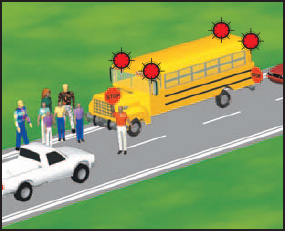
Blind intersections
The speed limit for a blind intersection is 15 mph. An intersection is considered “blind” if there are no stop signs at any corner and you cannot see for 100 feet in either direction during the last 100 feet before crossing. Trees, bushes, buildings, or parked cars at intersections can block your view to the side. If your view is blocked, edge forward slowly until you can see.
Alleys
The speed limit in any alley is 15 mph.
Near railroad tracks:
The speed limit is 15 mph within 100 feet of a railroad crossing where you cannot see the tracks for 400 feet in both directions. You may drive faster than 15 mph if the crossing is controlled by gates, a warning signal, or a flagman.
At railroad or train crossings:
- Look in both directions and listen for trains. Many crossings have multiple tracks so be ready to stop before crossing, if necessary. Cross railroad tracks only at designated
crossings and only when it is safe to do so. - Expect a train on any track at any time traveling in either direction. If you need to stop after crossing the tracks, make sure your vehicle clears the tracks before you stop.
- Never stop on the railroad tracks. Remember that a train cannot stop quickly or swerve out of the way. If you are on the tracks, you risk injury or death.
- Watch for vehicles that must stop before crossing train tracks. These vehicles include buses, school buses, and trucks transporting hazardous loads.
- Remember that flashing red lights mean STOP! Stop at least 15 feet from the nearest track when the crossing devices are active or a person warns you a train is coming. Stop if you see a train coming or you hear the whistle, horn, or bell of an approaching train.
- Do not go around or under lowered crossing gates, even if you do not see a train. Wait for the gates to rise. If the gates are not working correctly, call the railroad emergency number posted near the crossing or notify the local police or California Highway Patrol.
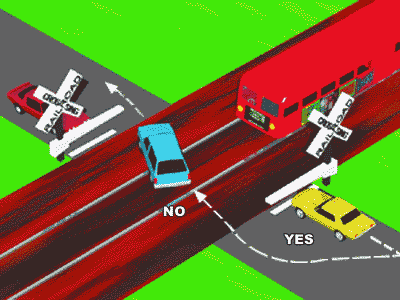
Near light rail vehicle crossings
The same rules apply to light rail vehicle crossings as to train crossings. Do not proceed across the tracks until you can see clearly in both directions and are sure that no other light rail vehicle or train is coming. Do not go around or under any closed gate.
NOTE: Light rail vehicles are very quiet and move more quickly than freight trains.
Near streetcars, trolleys, or buses
The passing speed limit, when safe to pass, is no more than 10 mph. This speed limit applies at a safety zone or an intersection where a streetcar, trolley, or bus is stopped and traffic is controlled by a police officer or traffic signal. A safety zone is marked by raised buttons or markers on the road and is set aside for pedestrians. You will most often see safety zones in areas where street cars or trolleys and vehicles share the roadway.
Business or residence districts
The speed limit is 25 mph, unless otherwise posted.
Near animals
If you see animals or livestock, slow down and obey the person in charge of the animals. If you see a stray animal in your path, slow down or stop, if safe to do so.
California Driver Handbook
Line Colors
Solid yellow lines mark the center of a road used for two-way traffic.
Broken yellow lines mean you may pass if the broken line is next to your driving lane.
Two solid yellow lines mean "no passing." Never drive to the left of these lines unless you are:
- Turning left at an intersection.
- Turning into or out of a private road or driveway.
- In a carpool lane that has a designated entrance on the left.
- Instructed to drive on the other side of the road because your side is closed or blocked.
Examples of lane markings
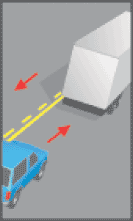
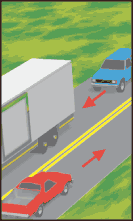
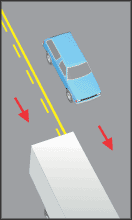
(1) Solid yellow line: No passing when solid yellow line is on your side.
(2) Double solid lines: No vehicle may pass.
(3) Broken yellow line: May pass if movement can be made in safely.
Two sets of solid double yellow lines spaced two or more feet part are considered a barrier. Do not drive on or over this barrier or make a left turn or a U-turn across it except at designated openings. (See "B" below)
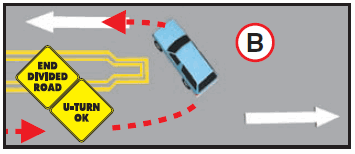
Solid white lines mark traffic lanes going in the same direction, such as one-way streets.
Broken white lines separate traffic lanes on roads with two or more lanes in the same direction.
Choosing A Lane
Traffic lanes are often referred to by number. The left or "fast" lane is called the "No. 1 Lane." The lanes to the right of the No. 1 lane are called the No. 2 lane, then the No. 3 lane. etc.
Example of numbered traffic lanes
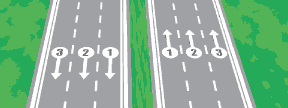
Drive in the lane with the smoothest flow of traffic. If you can choose among three lanes, pick the middle lane for the smoothest driving. To drive faster, pass, or turn left, use the left lane. When you choose to drive slowly or enter or turn off the road, use the right lane.
If there are only two lanes in your direction, pick the right lane for the smoothest driving.
Don’t weave in and out of traffic. Stay in one lane as much as possible. Once you start through an intersection, keep going. If you start to make a turn, follow through. Last second changes may cause accidents. If you missed a turn, continue to the next intersection and work your way back to where you want to go.
Changing Lanes
Changing lanes includes:
- Moving from one lane to another.
- Entering the freeway from an on-ramp.
- Entering the road from a curb or the shoulder.
Before changing lanes, signal, look in all your mirrors, and:
- Check traffic behind and beside you.
- Glance over your left or right shoulder to make sure the lane you want is clear.
- Look for vehicles or motorcyclists in your blind spot.
- Be sure there is enough room for your vehicle in the next lane.
Bicycle Lanes
A bicycle lane is shown by a solid white line along either side of the street, four or more feet from the curb. The white line will usually be broken near the corner and the words "BIKE LANE" will be painted in the lane. When you are making a right turn and are within 200 feet of the corner or other driveway entrance, you must enter the bike lane for the turn. Do not drive in the bike lane at any other time.
You may park in a bike lane unless a "No Parking" sign is posted.
Pedestrians are not allowed in bike lanes when sidewalks are available. Drivers of motorized bicycles should use bike lanes carefully to avoid accidents with bicyclists.
Passing Lanes
Before you pass, look ahead for road conditions and traffic that may cause other vehicles to move into your lane.
Never drive off the paved or main-traveled portion of the road or on the shoulder to pass. The edge of the main-traveled portion of the road has a painted white line on the road’s surface. Passing other vehicles at crossroads, railroad crossings, and shopping center entrances is dangerous.
Pass traffic on the left. You may pass on the right only when:
- An open highway is clearly marked for two or more lanes of travel in your direction.
- The driver ahead of you is turning left and you do not drive off the roadway. Never pass on the left if the driver is signaling a left turn.
When passing a bicyclist, pass on the left. If you are in a narrow traffic lane, wait until the traffic clears in the opposite lane before passing a bicyclist. Do not squeeze past the bicyclist.
Right Wrong
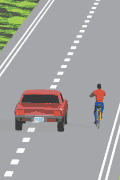
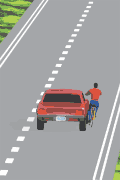
Carpool Lanes And Onramps
A carpool lane is a special freeway lane only for buses and/or carpools. You may use a carpool lane or onramp if your vehicle carries the minimum number of people required for the carpool lane or you drive a low-emission vehicle displaying a special DMV-issued decal. Motorcycle riders may use designated carpool lanes, unless otherwise posted.
Signs at the onramp or along the freeway tell you the minimum number of people required for the carpool and the hours the carpool requirement applies. The pavement in this lane is marked with a diamond symbol (◊) and the words "Carpool Lane." These lanes are also known as high-occupancy vehicle (HOV) lanes. Do not cross over double parallel solid lines to enter or exit any carpool lane except at designated entry or exit places.
Vehicles towing trailers are typically not allowed to use carpool lanes because they must drive more slowly and are usually restricted to the right-hand lane.

Center Left Turn Lanes
A center left turn lane is in the middle of a two-way street and is marked on both sides by two painted lines. The inner line is broken and the outer line is solid. If a street has a center left turn lane, you must use it when you turn left (VC §21460.5[c]) or start a permitted U-turn. You may only drive for 200 feet in the center left turn lane. This lane is not a regular traffic lane or a passing lane. To turn left from this lane, signal and drive completely inside the center left turn lane. Do not stop with the back of your vehicle blocking traffic. Make sure the lane is clear in both directions and then turn only when it is safe. Look for vehicles coming toward you in the same lane to start their left turn.
When turning left from a side street or driveway, signal and wait until it is safe. Then drive into the center left turn lane. Enter traffic only when it is safe.
You may drive across a center left turn lane.
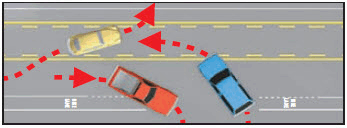
Turnout Areas and Lanes
Special "turnout" areas are sometimes marked on two-lane roads. Drive into these areas to allow cars behind you to pass.
Some two-lane roads have passing lanes. If you are driving slowly on a two-lane highway or road where passing is unsafe, and five or more vehicles are following you, drive into the turnout areas or lanes to let the vehicles pass.
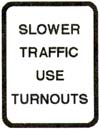
End-of-Lane Markings
Freeway lanes (as well as some city street lanes) which are ending, will usually be marked by large broken lines painted on the pavement. If you are driving in a lane marked with these broken lines, be prepared to exit the freeway or for the lane to end. Look for a sign that tells you to exit or merge, etc.
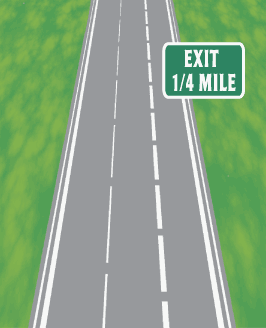
California Driver Handbook
Laws and Rules of the Road - TURNS
Left turns. To make a left turn, drive close to the center divider line or into the left turn lane. Begin signaling about 100 feet before the turn. Look over your left shoulder and reduce your speed. Stop behind the limit line. Look left, then right, then left again and make the turn when it is safe. When you turn left, do not turn too soon and “cut the corner” of the lane belonging to the vehicles coming towards you.
Safety suggestion: While waiting to turn left, keep your wheels pointed straight ahead until it is safe to start your turn. If your wheels are pointed to the left and a vehicle hits you from behind, you could be pushed into oncoming traffic.
Left turn against a red light on a one-way street only. Signal and stop for a red traffic light at the limit line or corner. You may turn left into a left-moving one-way street if there is no sign to prohibit the turn. Yield to pedestrians, bicyclists or other vehicles moving on their green light.
Example of a left turn.

Example of a right turn.
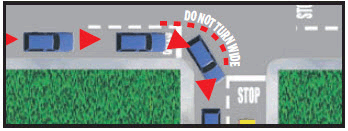
Right turns. To make a right turn, drive close to the right edge of the road. If there is a bike lane, drive into the bike lane no more than 200 feet before the turn. Watch for bicyclists or motorcyclists who may get between your vehicle and the curb. Begin signaling about 100 feet before the turn. Look over your right shoulder and reduce your speed. Stop behind the limit line. Look both ways and turn when it is safe. Do not turn wide. Complete your turn in the right lane.
Right turn against a red light. Signal and stop for a red traffic light at the limit line or at the corner. If there is no sign to prohibit the turn, you may turn right. Yield to pedestrians, bicyclists or other vehicles moving on their green light.
No Turn Against A Red Arrow. You may not turn right or left against a red arrow.
Examples Of Right and Left Turns
The numbers on the cars refer to the numbered sentences on these pages. Always use your turn
signals.
1. Left turn from a two-way street. Start the turn in the left lane closest to the middle of the street. Complete the turn in either lane of the cross street (shown by arrows), if safe. Use the center left turn lane if there is one. A left turn may be made from the other lane, if permitted by signs or arrows.
2. Right turn. Begin and end the turn in the lane nearest the right hand curb. Do not swing wide into another lane of traffic. Watch for bicyclists between your vehicle and the curb. Sometimes, signs or pavement markings will let you turn right from another lane (shown by * below).
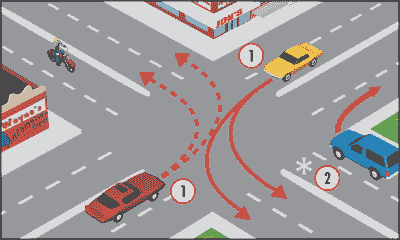
3. Left turn from a two-way street into a one-way street. Start the turn from the lane closest to the middle of the street. Turn into any lane that is safely open, as shown by the arrows.
4. Left turn from a one-way street into a two-way street. Start the turn from the far left lane. Turn into either of the lanes that is safely open, as shown by the arrows.
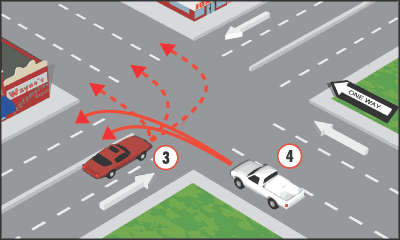
5. Left turn from a one-way street into a one-way street. Start the turn from the far left lane. Watch for bicyclists between your vehicle and the curb because they can legally use the left turn lane for their left turns. Turn into any lane that is safely open, as shown by the arrows.
6. Right turn from a one-way street into a one-way street. Start the turn in the far right lane. If safe, you may end the turn in any lane. Sometimes, signs or pavement markings will let you turn right from another lane (shown by *)
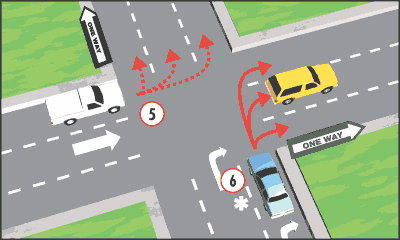
7. Turn at a "T" intersection from a one-way street into a two-way street. Through traffic has the right of way. You may turn either right or left from the center lane. Watch for vehicles and bicyclists inside your turn.
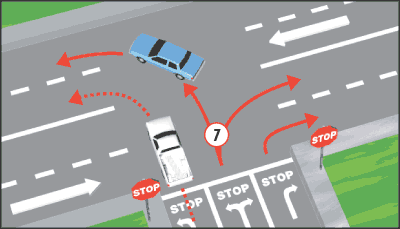
Legal U-Turns
A U-turn is turning around in the street to go back the way you came. To make a U-turn, signal and use the far left lane or the center left turn lane. You may make a U-turn:
- Across a double yellow line when it is safe and legal.
- In a residential district:
- if no vehicle approaching you is closer than 200 feet.
- whenever a traffic sign or signal protects you from approaching vehicles.
- At an intersection on a green light or green arrow unless a "No U-turn" sign is posted.
- On a divided highway only if an opening is provided in the center divider.
Illegal U-Turns
Never make a U-turn:
- On a divided highway by crossing a dividing section, curb, strip of land, or two sets of double lines.
- Where you cannot clearly see 200 feet in each direction because of a curve, hill, rain, fog, or other reason.
- Where a "No U-Turn" sign is posted.
- When other vehicles may hit you.
- On a one-way street.
- In front of a fire station. Never use a fire station driveway to turn around.
- In business districts. Areas with churches, apartments, multiple dwelling houses, clubs, and public buildings (except schools) are also considered to be business districts. Turn only at an intersection or where openings are provided for turns.
California Driver Handbook
Laws and Rules of the Road - PARKING
Parking On A Hill
When you park:
- On a sloping driveway, turn the wheels so the car will not roll into the street if the brakes fail.
- Headed downhill, turn your front wheels into the curb or toward the side of the road. Set the parking brake.
- Headed uphill, turn your front wheels away from the curb and let your vehicle roll back a few inches. The back of the front wheel should gently touch the curb. Set the parking brake.
- Headed either uphill or downhill and there is no curb, turn the wheels so the car will roll away from the center of the road if the brakes fail.
Always set your parking brake and leave the vehicle in gear or the "park" position.
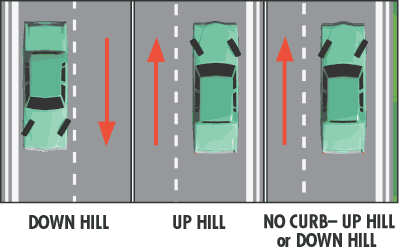
Parking At Colored Curbs
Painted colored curbs have the following special parking rules:
White: Stop only long enough to pick up or drop off passengers or mail.
Green: Park for a limited time. Look for a sign next to the green zone or for the time painted on the curb.
Yellow: Stop no longer than the time posted to load or unload passengers or freight. Drivers of noncommercial vehicles are usually required to stay with the vehicle.
Red: No stopping, standing, or parking. (Buses may stop at a red zone marked for buses.)
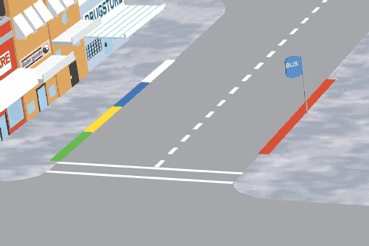
Blue: Parking is permitted only for a disabled person who displays a placard or disabled person or disabled veteran license plates. Disabled people with a placard or special plates may park in special areas for unlimited periods of time, regardless of time restrictions. No one else may park there. Qualified persons may apply at any DMV office for a parking placard or special plates.
An identification card will be issued to holders of disabled person or disabled veteran license plates.
NOTE: Placard abuse results in loss of special parking privileges. It is also a misdemeanor and is punishable by a fine of up to $1000, imprisonment in county jail for up to six months, or both.

Illegal Parking
Never park or leave your vehicle:
- Where a "No Parking" sign is posted.
- On a marked or unmarked crosswalk, on a sidewalk, or in front of a driveway.
- Within three feet of a sidewalk ramp for disabled persons or in front of or on a curb which provides wheelchair access to a sidewalk.
- In a disabled person parking space unless you are disabled and display a placard or special plates.
- In the space next to a disabled person parking space if it is painted in a crosshatched pattern. (VC §22507.8)
- In a space designated for parking or fueling zero-emission vehicles which display an identifying decal.
- In a tunnel or on a bridge, except where permitted by signs.
- Within 15 feet of a fire hydrant or a fire station driveway.
- On or within 71/2 feet of a railroad track.
- Between a safety zone and the curb.
- "Double parked." (Parking in the street when all legal parking places at the curb are taken.)
- On the wrong side of the street.
- At a red curb.
- On a freeway, except:
- in an emergency or
- when an officer or device requires a stop or
- where a stop is specifically permitted. A vehicle (even if disabled) that is stopped, parked, or left standing on a freeway for more than four hours may be removed. (VC §22651[f])
NOTE: If you must stop on a highway, park completely off the pavement and stay in your vehicle with the doors locked until help arrives. Leave enough space for other vehicles to pass freely. Your car should be visible at least 200 feet in each direction.
Example of crosshatched pattern

Special Parking Rules
- When you park alongside a curb, the front and back wheels must be parallel and within 18 inches of the curb. Park parallel to the street if there is no curb.
- Never leave your car until you have stopped the engine and set the parking brake.
- Do not open the driver’s side doors unless it is safe and you do not interfere with traffic. Look for passing bicyclists and motorcyclists. Do not leave the door open any longer than necessary
California Driver Handbook
Laws and Rules of the Road -
SIGNALING
Always signal to other drivers when you plan to turn left, right, slow down, or stop. Signals may be given by hand-and-arm positions or by using the vehicles signal lights. If bright sunlight makes the signal lights hard to see, use hand-and-arm signals also.
LEFT TURN
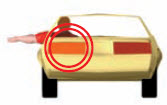
RIGHT TURN
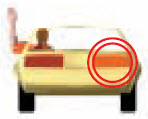
SLOW OR STOP
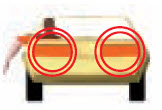
Motorcyclists often use hand signals to make themselves more visible. Bicyclists may give right turn signals with their right arm held straight out, pointing right.
Always signal:
- Your left or right turn during the last 100 feet before reaching the turning point. Caution— Even though you signal, do not automatically assume that the space you wish to occupy is clear.
- Before every lane change. Also, look over your shoulder and check your blind spot before changing lanes.
- At least five seconds before you change lanes at freeway speeds.
- To let other drivers know your plans.
- Before pulling next to or away from the curb.
- When you change directions.
- Even when you don’t see other vehicles around. A vehicle you don’t see might hit you.
If you plan to turn beyond an intersection, start signaling when you are in the intersection. If you signal too early, the other driver may think you plan to turn into the intersection and he/she may pull out in front of you.
Remember to cancel your signal after turning if it doesn’t turn off by itself.
ADDITIONAL DRIVING RULES
Things you must not do:
- Do not drive a vehicle so loaded, either with property or people, that you cannot control it, see ahead, or to the sides of your vehicle.
- Do not carry anything in or on a passenger vehicle which extends beyond the fenders on the left side or more than six inches beyond the fenders on the right side. A load extending more than four feet from the back of the vehicle must display a 12-inch red or fluorescent orange square flag or two red lights at night.
- Do not allow anyone to ride on any part of your vehicle not intended for passengers.
- Do not allow anyone to ride in the trunk of your vehicle. Convictions will result in penalties for both the driver and the person(s) riding in the trunk.
- Do not allow a person to ride in the back of a pickup or other truck unless the vehicle is equipped with seats and the person uses both the seat and a safety belt.
- Do not transport animals in the back of a pickup or other truck unless the animal is properly secured.
- Do not dump or abandon animals on a highway. This crime punishable by a fine of up to $1000, six months in jail, or both.
- Do not tow anyone who is riding a bicycle, in a wagon, on roller skates, on a sled, on skis, or on a toy vehicle.
- Do not litter the roadside. The fine is $1000 and you may be forced to pick up what you threw away. Littering convictions show on your driving record.
- Do not wear a headset over, or earplugs in, both your ears.
- Do not wear eyeglasses with temples wide enough to keep you from seeing clearly to the sides.
- Do not drive a vehicle equipped with a video monitor if the monitor is visible to the driver and displays anything other than vehicle information or global mapping displays.
- Do not honk your horn unless it is a safety warning.
- Do not throw any cigarette, cigar, or other flaming or glowing substance from your vehicle.
- Do not shoot firearms on a highway or at traffic signs.
- Do not block your view by putting signs or other objects on the front windshield or the back and side windows. Do not hang objects on the mirror. Windshield/window stickers, etc., are permitted in these locations only:
- A seven-inch square on either the passenger’s side windshield, lower corner; or the rear window, lower corner.
- A five-inch square on the driver’s side, lower corner.
- Side windows behind the driver.
- Do not drive any motor vehicle into a designated wilderness area. (VC §38301.5)
- Do not drive with tinted safety glass. If you have sun-sensitive skin, you may use removable sun screens during daylight travel if you have a letter from your physician.
- Do not block or hinder a funeral procession. Vehicles taking part in a funeral procession have the right of way and if you interfere, obstruct, or interrupt the funeral procession, you are subject to a citation. (VC §2817) The funeral procession is led by a traffic officer and all vehicles taking part in the procession have windshield markers to identify them.
- Do not ride, or allow a child to ride, a “pocket bike” on a public street or highway. These vehicles are not manufactured or designed for highway use and they do not meet federal safety standards.
Things you must do:
- You must drive as far to the right as reasonably possible on narrow mountain roads, and if you cannot see at least 200 feet ahead, honk your horn.
- You must use your headlights 30 minutes after sunset and leave them on until 30 minutes before sunrise.
- You must dim your lights to low beams within 500 feet of a vehicle coming toward you or within 300 feet of a vehicle you are following.
- You must turn on your headlights if snow, rain, fog, or low-visibility (1000 feet or less) require the use of windshield wipers.
- You must move your vehicle out of the traffic lane (unless it is disabled) when it is safe to do so, if you are involved in an accident. Law enforcement may tow or impound your vehicle if it is left in an unsafe area and causes safety concerns.

1 comment:
nice information regarding road rules also follow the radar speed sign,speed display signs,speed display.
Post a Comment